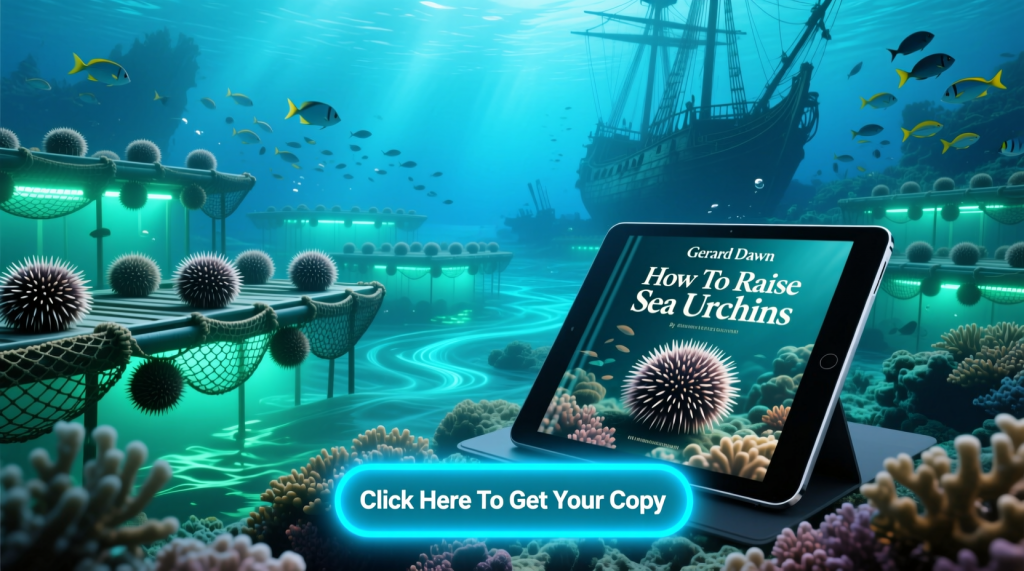Sea urchin aquaculture has gained significant attention due to the high demand for their roe (gonads), a delicacy in global markets, particularly in Japan, Europe, and North America. However, profitability in sea urchin farming heavily depends on feed efficiency, growth rates, gonad quality, and production costs.
Optimizing feed formulations and feeding strategies is crucial for maximizing profitability. This paper explores key aspects of sea urchin aquaculture feed, including nutritional requirements, alternative feed sources, cost-effective production methods, and strategies to enhance gonad yield and quality.
Table of Contents
1. Nutritional Requirements for Sea Urchin Aquaculture
Sea urchins are primarily herbivorous, feeding on algae and detritus in the wild. In aquaculture, their diet must replicate natural nutrition to ensure optimal growth and gonad development. Key nutritional components include:
1.1 Protein
- Essential for tissue growth and gonad development.
- Optimal protein levels: 20-30% of the diet.
- Sources: Fishmeal, soybean meal, macroalgae (e.g., Ulva, Gracilaria).
1.2 Carbohydrates
- Provide energy and influence gonad sweetness.
- Macroalgae (e.g., kelp, Laminaria) are rich in polysaccharides.
- Processed feeds may include wheat or cornmeal as binders.
1.3 Lipids
- Critical for gonad quality (color, texture, flavor).
- Omega-3 fatty acids (EPA, DHA) improve market value.
- Sources: Fish oil, microalgae (Schizochytrium), seaweed lipids.
1.4 Vitamins & Minerals
- Vitamin C & E: Enhance immune function and gonad quality.
- Calcium & Phosphorus: Essential for test (shell) development.
- Carotenoids (Astaxanthin, β-carotene): Improve gonad color (desired orange/red hue).
2. Feed Formulations for Cost-Effective Production
Commercial sea urchin feeds must balance nutrition, palatability, and affordability.
2.1 Natural Algae-Based Feeds
- Advantages: Mimic wild diet, high digestibility.
- Disadvantages: Seasonal availability, high cost.
- Common species: Laminaria japonica, Gracilaria, Ulva lactuca.
2.2 Processed Pelleted Feeds
- Advantages: Consistent nutrition, year-round availability.
- Formulation example:
- 30% Fishmeal (protein)
- 20% Soybean meal (protein)
- 30% Macroalgae meal (carbs/fiber)
- 10% Wheat flour (binder)
- 5% Fish oil (lipids)
- 5% Vitamin/mineral premix
2.3 Alternative Protein Sources (Cost Reduction)
- Insect meal (Black soldier fly larvae): Sustainable, high protein.
- Single-cell proteins (Yeast, bacteria): Fermented feeds improve digestibility.
- Plant-based proteins (Soy, pea protein): Cheaper but may require supplementation.
2.4 Waste Utilization (Circular Economy Approach)
- Seaweed processing waste: Upcycled into feed.
- Fish processing by-products: Heads, viscera as protein sources.
3. Feeding Strategies to Maximize Gonad Yield & Quality
Profitability hinges on gonad (roe) quality, which is influenced by feed and feeding regimes.
3.1 Gonad Enhancement Diets (Last 8-12 Weeks Before Harvest)
- High-protein (30-35%) + High-lipid (10-15%) feeds boost gonad size.
- Carotenoid supplementation enhances color (e.g., Haematococcus pluvialis microalgae).
3.2 Restricted Feeding vs. Ad Libitum Feeding
- Restricted feeding (3-5% body weight/day) improves feed conversion ratio (FCR).
- Ad libitum feeding leads to faster growth but higher costs.
3.3 Seasonal Feeding Adjustments
- Summer (Active growth): Higher protein for somatic growth.
- Winter (Gonad maturation): Lipid-rich diets for roe development.
4. Economic Considerations & Profitability Optimization
4.1 Feed Cost Breakdown
- Algae-based feeds: $1.50–$3.00/kg (higher cost but premium quality).
- Pelleted feeds: $0.80–$1.50/kg (more economical).
- Alternative proteins (insect/yeast): $1.00–$2.00/kg (emerging cost benefits).
4.2 Feed Conversion Ratio (FCR) Optimization
- Target FCR: 2:1 (2 kg feed per 1 kg gonad weight gain).
- Strategies to improve FCR:
- Use of digestible protein sources.
- Pre-soaking pellets to reduce waste.
- Automated feeders to reduce overfeeding.
4.3 Reducing Feed Waste & Environmental Impact
- Slow-sinking pellets minimize uneaten feed.
- Recirculating Aquaculture Systems (RAS) allow feed recovery.
4.4 Market-Driven Feed Adjustments
- Japanese market preference: Bright orange roe → High carotenoid feeds.
- European market preference: Firm texture → Protein-rich diets.
5. Future Innovations in Sea Urchin Feed
5.1 Probiotic & Prebiotic Supplementation
- Improves gut health, nutrient absorption.
- Reduces disease, lowering mortality rates.
5.2 3D-Printed Feeds
- Custom nutrient profiles for different growth stages.
5.3 Algae Biofactories
- Genetically modified microalgae for enhanced nutrient profiles.
Here are 10 frequently asked questions (FAQs) about sea urchins:
1. What do sea urchins eat?
Sea urchins are primarily herbivores, feeding on algae, kelp, and other marine plants. Some species also eat small invertebrates or decaying matter.
2. Are sea urchins poisonous or dangerous to humans?
Most sea urchins are not poisonous, but some have venomous spines (e.g., flower urchins). Even non-venomous species can cause painful puncture wounds if stepped on.
3. How do sea urchins move?
They use tiny tube feet (part of their water vascular system) to crawl along surfaces. Some species also use their spines for locomotion.
4. Can you eat sea urchins?
Yes! Sea urchin roe (gonads), called uni in Japanese cuisine, is a delicacy in sushi and seafood dishes.
5. Do sea urchins have eyes?
No, they don’t have eyes, but they can sense light and dark through photoreceptor cells on their bodies.
6. How long do sea urchins live?
Depending on the species, they can live from 5 to over 100 years (e.g., red sea urchins can live up to 200 years!).
7. Why are sea urchin populations increasing in some areas?
Overfishing of their natural predators (like sea otters and lobsters) and warming oceans contribute to population booms, which can harm kelp forests.
8. How do sea urchins reproduce?
They release eggs and sperm into the water (external fertilization). Larvae float in plankton before settling and growing into adults.
9. What’s inside a sea urchin?
They have a hard shell (test) with a mouth (Aristotle’s lantern for chewing), digestive organs, and reproductive organs (roe).
10. Are sea urchins important to the ecosystem?
Yes! They help control algae growth, maintain healthy kelp forests, and serve as food for many marine animals.

